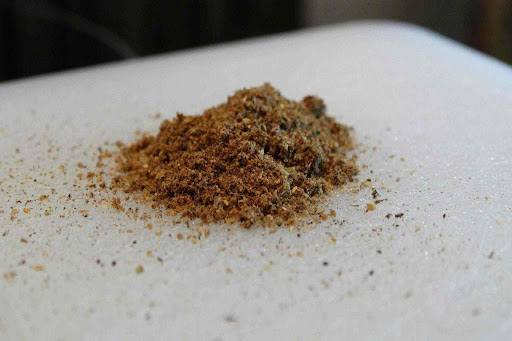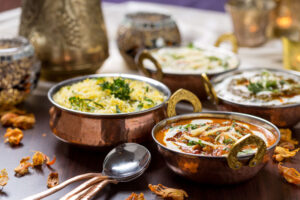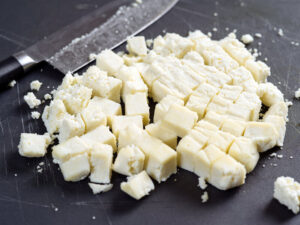The magic that spice blends bring to a dish, with added flavor, aroma, and depth, is like no other. Among the many spice blends available for culinary use, let’s look at baharat vs garam masala.
What Spice is Baharat?
Baharat corresponds to the Middle Eastern version of Masala. It is also known as Lebanese 7 Spice and may differ from country to country.
Baharat is the Arabic word for ‘spices’ and is a spice mixture or blend used in Middle Eastern cuisines.
It combines the following spices: cinnamon, cumin, cardamom, cloves, coriander seeds, nutmeg, smoked sweet paprika, and black pepper.
Here’s a short watch on how to make baharat spice mix:
What is Garam Masala?
Garam masala is a North Indian specialty. It corresponds to a powdered blend of highly aromatic spices, and it is made hot thanks to black pepper.
Garam translates to ‘hot’, and masala translates to ‘a mix of spices’.
Garam masala, a North Indian speciality is a powdered blend of highly aromatic spices & #blackpepper to make it hot. ???? To pep up the spicy aroma in any dish, it is sprinkled in small quantities when the dish is nearly ready. ????✅
— Dishi Spices (@DishiSpices) April 28, 2021
.
.#garammasala #masaledar #dishigarammasala pic.twitter.com/nqcl4ZZHrY
Is Baharat the Same as Garam Masala?
The flavor profile of baharat is similar to that of garam masala. This is because both contain many of the same spices and will be even more alike if the baharat spices are toasted before preparing the blend.
Perhaps, you’d also be interested in berbere vs garam masala.
What’s the Difference Between Garam Masala and Baharat?

While garam masala is commonly used in Indian cuisines, Baharat is more popular in the Middle East.
Garam masala contains bay leaves and Kashmiri red chilies or red chili powder, making it spicier than Baharat, which contains paprika. It also has more ingredients than Baharat.
Read into garam masala vs ras el hanout to learn about these two spices’ comparisons.
How to Make Baharat?
The ingredients you’ll need to make the Baharat spice mix include:
1/4 tsp ground nutmeg
1 tsp ground cinnamon
1 1/2 tbsp paprika
1/2 tsp cardamom seeds
1 tsp whole cloves
2 tsp coriander seeds
1 tbsp cumin seeds
1 tbsp black peppercorns
Here’s the simple method of preparation for Baharat:
- Keep the paprika, nutmeg, and cinnamon aside.
- Dry roast the remaining spices/seeds in a small skillet over medium-high heat for about 3 – 5 minutes. Keep tossing intermittently to prevent scorching.
- Once they’re fragrant, transfer to a bowl and allow to cool.
- Grind the roasted ingredients with the cinnamon, nutmeg, and paprika.
- Store in an airtight container.
What is Garam Masala Made Of?

The typical Indian version of garam masala contains:
- Kashmiri red chili powder
- Coriander seeds
- Cumin
- Black and green cardamom pods
- Mace
- Cinnamon
- Cloves
- Black and white peppercorns
- Bay leaves
- Fennel
Baharat vs Garam Masala: Substitutes
The spice mixes that can be used as a baharat substitute include:
- Garam masala
- Ras el Hanout
- Tandoori masala
- Tikka masala
- Berbere
As a garam masala substitute, you could go with one of the following:
- Curry powder
- Chaat masala
- Allspice and cumin (4 parts cumin mixed with 1 part allspice)
What Does Baharat Taste Like?

The flavor profile of the baharat spice blend is pungent, earthy, warm, and aromatic. It is a nice combination of smoky and sweet without any spiciness.
Although the taste isn’t overpowering, it’s best to use it in small amounts since it’s very aromatic.
What Does Garam Masala Taste Like?
It has a deep, savory flavor with peppery notes to warm the tongue, combined with fruity brightness. Garam masala is a perfect balance of flavors pungent, bitter, astringent, and sweet.
Can You Use Garam Masala Instead of Baharat?

Yes, garam masala is a good alternative to the Baharat spice mix. However, since it’s spicier than Baharat, it would be best to start with a smaller quantity and build up to the desired taste when substituting.
Baharat vs Garam Masala: Variations
There are several variations to both these spices from country to country.
Variants of Baharat
The sabaa baharat, originating from Aleppo, Syria, uses cinnamon, coriander, cardamom, cumin, black pepper, cloves, and nutmeg.
In North African versions, some crushed rose petals are added. In some other places, it is the gold of turmeric which is added.
The Turkish baharat has a large proportion of mint, while in Eastern Arabia, dried black lime and saffron may also be used for baharat.
In Tunisia, it’s a simple mixture of ground cinnamon and dried rosebuds, often combined with black pepper.
Variations of Garam Masala
The Burmese masala spice blend has cassia or ground cinnamon, cloves, cardamom, and black pepper.
In the eastern part of the Indian subcontinent, in Bangladesh, Assam, Orissa, and West Bengal, only clove, cinnamon, and cardamom may be substituted for the assortment.
Are There Any Health Benefits of Garam Masala?
Indeed there are. Here are the 5 powerful health benefits of high-quality garam masala:
- Prevents diabetes
- Lowers the risk of cancer
- Reduces inflammation
- Regulates blood pressure and promotes heart health
- Improves digestion
Baharat vs Garam Masala: Uses
The uses of these spice mixes are vast, spanning different types of dishes to enhance their flavor.
Baharat can be used for the following purposes:
- Can be used as an all-purpose dry rub or as a dry rub on its own to grill meat.
- Mixing it with olive oil gives a paste similar to harissa paste, which can be used as a marinade.
- Makes an excellent addition to yogurt-based condiments and even to season hummus.
- Add to soups or sprinkle over finished dishes as a condiment.
- Seasoning for beef, seafood, chicken, lamb, and vegetable recipes.
- Egypt’s national dish, koshary, uses baharat.

Garam masala is typically added towards the end of the cooking for most recipes. The strong, vibrant flavor of garam masala makes it suitable to use for:
- Many North-Indian dishes, including chana masala, butter chicken, chicken tikka masala, Indian butter chicken, saag tofu, etc.
- As a dry rub for meats
- Sprinkling in soups
- Vegetable samosas
Garam Masala vs Baharat: Where to Purchase
Garam masala can be found in any Indian or international supermarket. It is also available when you order Indian groceries online and probably even at dedicated spice shops.
Some of the brands that have the best chicken masala powder or the best shahi paneer masala brand also offer equally good garam masala.
On the other hand, baharat can be purchased from Middle Eastern grocery stores, well-stocked gourmet shops, and even online.
Their flavors diminish over time regardless of where you buy these spice mixes. Hence you must purchase the freshest possible.
However, making small batches of these spice mixes when required is highly recommended, and storing them in airtight containers to retain their aroma and flavor.










